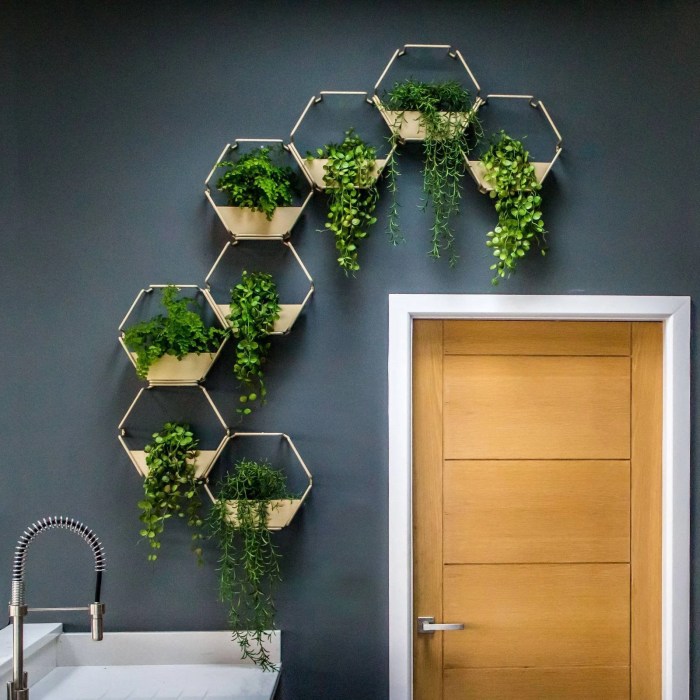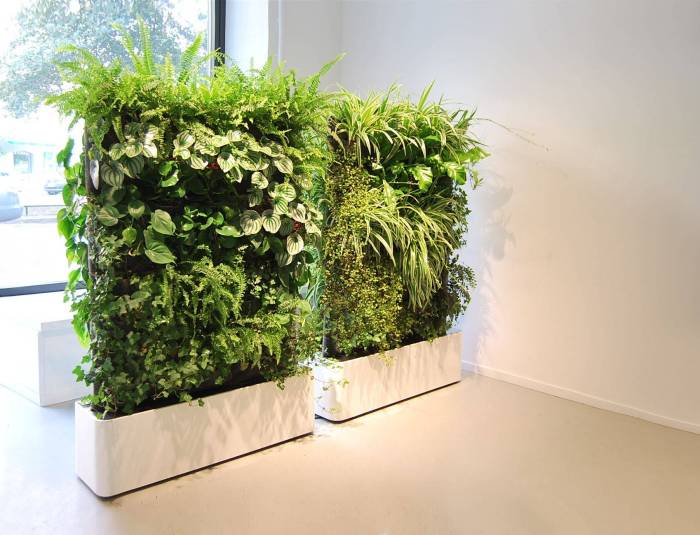Wall planters indoor are a stylish and functional way to bring nature into your home. With a wide variety of styles, materials, and sizes to choose from, there’s a wall planter perfect for any space. Whether you’re looking to add a touch of greenery to a small apartment or create a living wall in your living room, wall planters are a great way to add life and beauty to your home.
In this article, we’ll explore the different types of wall planters available, discuss the factors to consider when choosing plants for wall planters, and provide tips for installing and maintaining your wall planters.
Wall Planter Types

Wall planters come in various types, catering to diverse styles and plant needs. These planters differ in materials, shapes, and sizes, offering a wide range of options for indoor decoration.
Materials
Wall planters are crafted from various materials, each offering unique advantages. Ceramic planters, renowned for their durability and elegance, come in glazed or unglazed finishes. Metal planters, such as those made of copper or iron, provide a modern and industrial aesthetic.
Plastic planters, lightweight and affordable, offer versatility in terms of color and shape. Wooden planters, exuding a natural and rustic charm, are suitable for both indoor and outdoor use.
Shapes
Wall planters come in an array of shapes, allowing for creative arrangements. Rectangular planters, with their clean lines and spacious interiors, are ideal for displaying trailing plants or creating a vertical garden. Round planters, with their soft curves, lend a touch of elegance to any space.
Hexagonal planters, with their geometric design, add a touch of modernity and visual interest.
Sizes, Wall planters indoor
Wall planters vary in size, accommodating plants of different sizes and growth habits. Small planters are suitable for succulents, herbs, or trailing plants. Medium planters provide ample space for larger plants, such as ferns or peace lilies. Large planters, with their generous capacity, are ideal for showcasing statement plants or creating a lush indoor oasis.
Plant Selection for Wall Planters
When selecting plants for wall planters, it’s crucial to consider factors such as light requirements, water needs, and size.
Light Requirements
Light is essential for plant growth. Determine the amount of natural light your wall planter will receive and choose plants accordingly. For low-light areas, consider shade-tolerant species like ferns, pothos, or peace lilies. For brighter locations, opt for plants like succulents, cacti, or orchids.
Water Needs
Watering frequency varies depending on the plant species and the size of the wall planter. Some plants, such as succulents and cacti, are drought-tolerant and require infrequent watering. Others, like ferns and mosses, prefer consistently moist soil.
Size
Consider the size of the wall planter and the available space when selecting plants. Small planters are suitable for trailing plants or compact varieties, while larger planters can accommodate taller or bushier plants. Avoid overcrowding the planter to ensure proper air circulation and growth.
Suitable Plant Options
Here’s a list of suitable plants for indoor wall planters, along with their care requirements:
- Ferns:Prefers low to medium light and consistently moist soil.
- Pothos:Tolerates low light and infrequent watering.
- Peace lilies:Enjoys low to bright indirect light and moist soil.
- Succulents:Thrives in bright light and well-draining soil, tolerates drought.
- Cacti:Requires bright light and infrequent watering, well-draining soil.
- Orchids:Prefers bright indirect light and humid conditions.
By considering these factors and selecting appropriate plants, you can create a thriving indoor wall garden that adds beauty and greenery to your space.
Wall Planter Installation
Installing wall planters is a straightforward process that can be accomplished using various methods, including hanging, mounting, and utilizing adhesive strips.
Hanging Wall Planters
Hanging wall planters is a popular method that allows for easy placement and adjustment. The process involves:
- Choosing a suitable hook or bracket for the planter’s weight.
- Marking the desired location on the wall and drilling a pilot hole.
- Installing the hook or bracket securely into the wall.
- Hanging the planter on the hook or bracket.
Mounting Wall Planters
Mounting wall planters is another option that provides a more permanent and secure installation. The process typically involves:
- Selecting appropriate mounting hardware, such as screws or anchors.
- Marking the mounting points on the wall and drilling pilot holes.
- Installing the mounting hardware into the wall.
- Aligning the planter with the mounting points and securing it in place.
Using Adhesive Strips
Adhesive strips are a convenient and damage-free option for installing small and lightweight wall planters. The process involves:
- Cleaning the surface of the wall and the back of the planter.
- Applying the adhesive strips to the back of the planter.
- Removing the protective backing from the adhesive strips.
- Pressing the planter firmly against the wall and holding it in place for several seconds.
Decorating with Wall Planters

Wall planters are not just for growing plants; they are also a versatile decorative element that can enhance the aesthetics of any home. Here are a few ideas for using wall planters to elevate your home decor:
Creating a Living Wall
A living wall is a vertical garden created using wall planters. It’s a great way to add greenery to small spaces, create a focal point, and improve air quality. Choose a variety of plants with different textures and colors to create a lush and vibrant living wall.
Adding Greenery to Small Spaces
Wall planters are a perfect solution for adding greenery to small apartments, studios, or balconies. They take up minimal floor space and can be placed on any wall, creating a sense of freshness and connection with nature.
Complementing Different Interior Styles
Wall planters come in a wide range of styles, from modern to rustic, making them suitable for any interior design scheme. Choose planters that match the color palette and overall aesthetic of your home to create a cohesive and visually appealing look.
Indoor wall planters, with their vertical orientation, offer a space-saving solution for greenery. If you’re seeking more options for suspended greenery, consider exploring Hanging Plants . They provide a comprehensive guide to various hanging plants, their care requirements, and stylish ways to incorporate them into your indoor space.
By combining wall planters and hanging plants, you can create a vibrant and lush indoor oasis that enhances both aesthetics and well-being.
Creative Wall Planter Arrangements
There are endless possibilities for arranging wall planters creatively. Here are a few ideas:
- Hang planters in a staggered pattern to create a dynamic and visually interesting display.
- Use a combination of different sizes and shapes of planters to add depth and dimension to the wall.
- Mount planters on a wooden board or shelf to create a custom planter display.
- Hang planters from the ceiling using macrame or twine to create a bohemian or eclectic look.
Wall Planter Maintenance

Maintaining wall planters is essential to keep your plants healthy and thriving. Proper care includes watering, fertilizing, and cleaning, ensuring your plants receive the necessary nutrients and hydration while preventing pests and diseases.
Watering
Watering wall planters differs from traditional planters due to their vertical orientation. Water tends to drain quickly, so it’s crucial to water thoroughly and regularly. Check the soil moisture regularly by inserting a finger or using a moisture meter. Water when the soil feels dry to the touch.
Fertilizing
Fertilize wall planters every few weeks during the growing season with a balanced liquid fertilizer diluted to half strength. Avoid over-fertilizing, as it can damage the roots.
Cleaning
Clean wall planters periodically to remove dust, debris, and algae. Use a soft cloth or brush to gently wipe the planter’s surface. For stubborn stains, use a mild soap solution. Cleaning prevents dirt buildup and ensures proper drainage.
Summary: Wall Planters Indoor
Wall planters are a versatile and affordable way to add style and functionality to your home. With a little planning and care, you can create a beautiful and thriving indoor garden that will bring you joy for years to come.
Helpful Answers
What are the different types of wall planters available?
Wall planters come in a variety of materials, including ceramic, metal, plastic, and wood. They also come in a variety of shapes and sizes, so you can find the perfect planter to match your style and space.
What factors should I consider when choosing plants for wall planters?
When choosing plants for wall planters, you need to consider the amount of light the planter will receive, the amount of water the plants will need, and the size of the planter. You should also choose plants that are easy to care for and that will thrive in the conditions in your home.
How do I install a wall planter?
There are a few different ways to install a wall planter. You can hang it from a hook or nail, mount it to the wall using screws, or use adhesive strips. The best method for installing your wall planter will depend on the type of planter you choose and the surface you are mounting it to.
How do I care for my wall planters?
Wall planters need to be watered regularly, but the frequency will vary depending on the type of plant you have and the conditions in your home. You should also fertilize your plants regularly and clean the planters occasionally to prevent dirt and debris from building up.